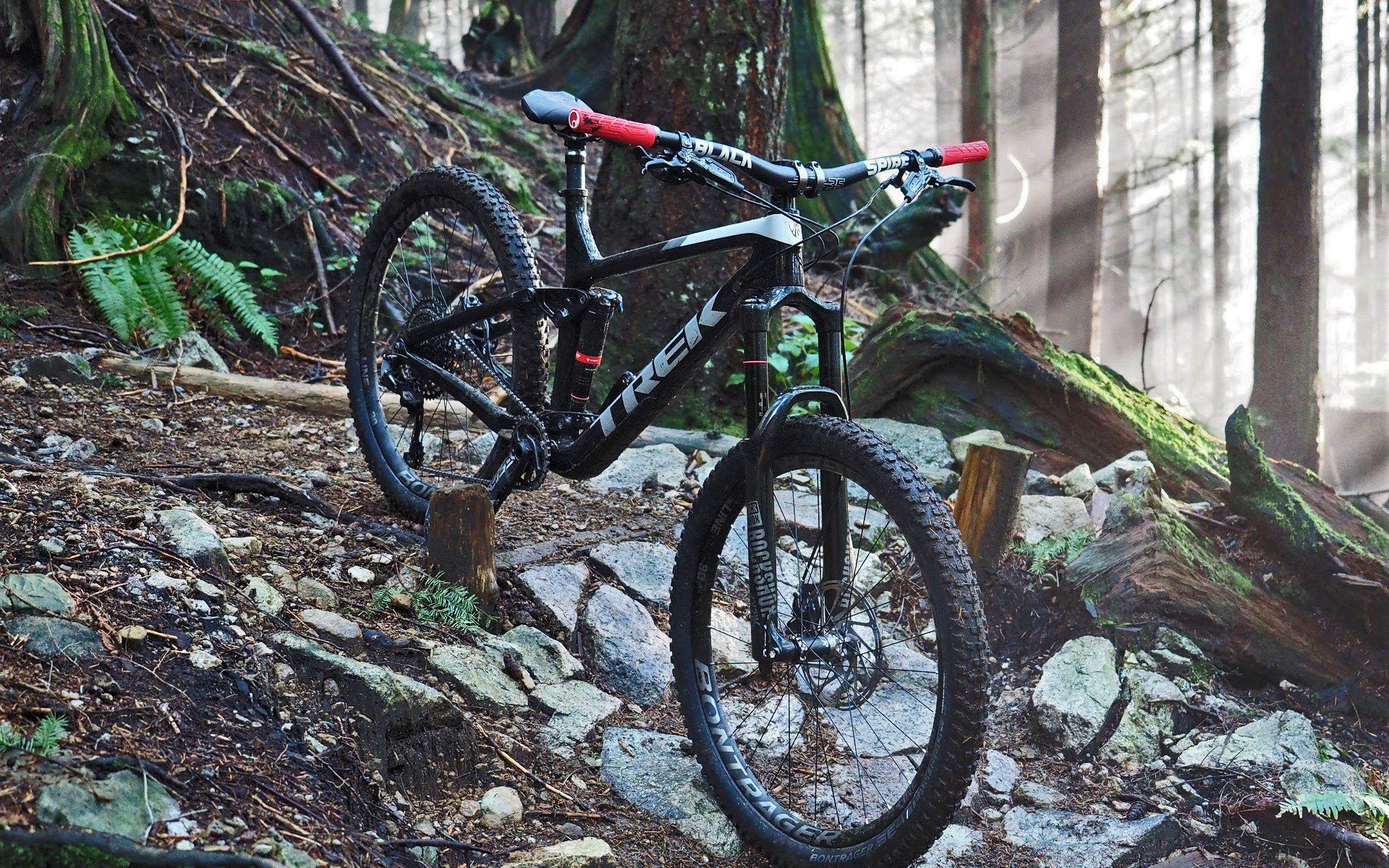
Teardown |Review
2018 Trek RE:aktiv Thru Shaft Shock
2018 Trek Remedy
2018 is the 10th anniversary of Trek's ABP Remedy model. It has marginally larger hoops and updated geometry but when I throw a leg over this 2018 9.8 I can't help but thinking about my first ride on a 2008 Remedy 8. Awesome bike. Awesome memories. A decade is a big deal but there's no sweet brown-and-orange remake of one of my favorite paint schemes of all time on a bike that still, as Pete says, hits "the heart of the do-it-all well spectrum".
My cynical side says it doesn't matter how great a product is; the market simply grows tired of steady improvements. Blow it up. Change it up. Make it 100% stiffer in ways that are either indiscernible or negative for most riders. Definitely, don't draw attention to the fact that the 2018 model looks a lot like it did when many were worried about Sarah Palin being a heartbeat from the presidency.
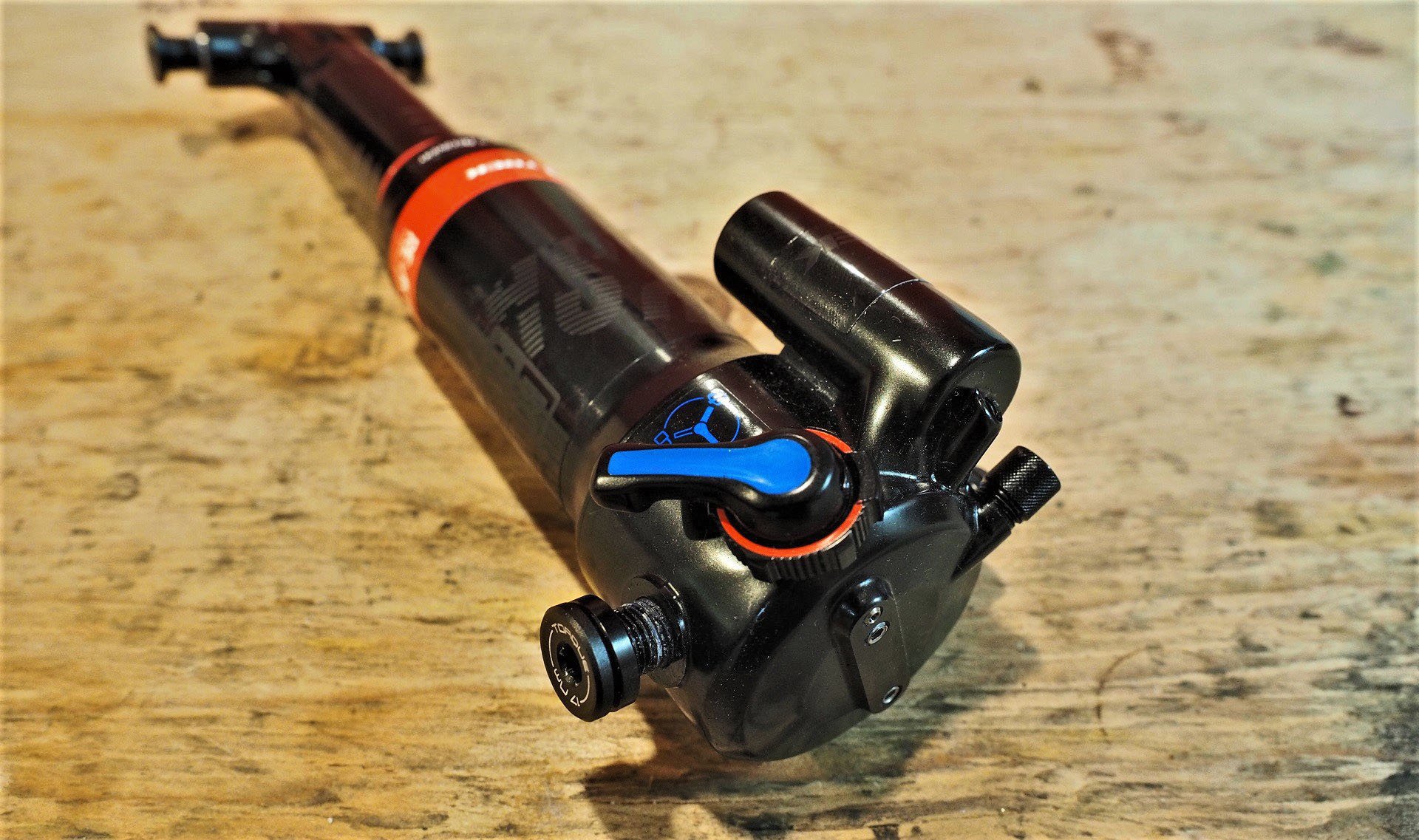
The 2018 Trek Remedy 9.8 sports the highly praised GX Eagle drivetrain but the big news is Trek's new Thru Shaft shock.
This isn't a review of the Remedy per se. Pete tested a 2017 model with the same frame and you can read about the ins-and-outs of the bike here. I'm specifically looking at the big change in Trek's full suspension line for 2018; the new Thru Shaft shocks from Fox and RockShox, with some help from my friend Jeff at Bikeroom and Trek's top suspension guru Jose Gonzalez.
Why Thru Shaft?
No dynamic internal floating piston (IFP) means no nitrogen charge. No nitrogen charge means the new Thru Shaft shocks are fully serviceable at your preferred local mountain bike shop or by any rider with the time, confidence, and tools.
With low internal pressures, reduced friction and the shaft exiting its aluminum sauna during compression, the Thru Shaft shock runs much cooler and damper oil degradation is colossally reduced. I know how that sounds but RockShox is recommending a full service on the shocks every 200hrs of riding which is an impressive interval for an air shock.
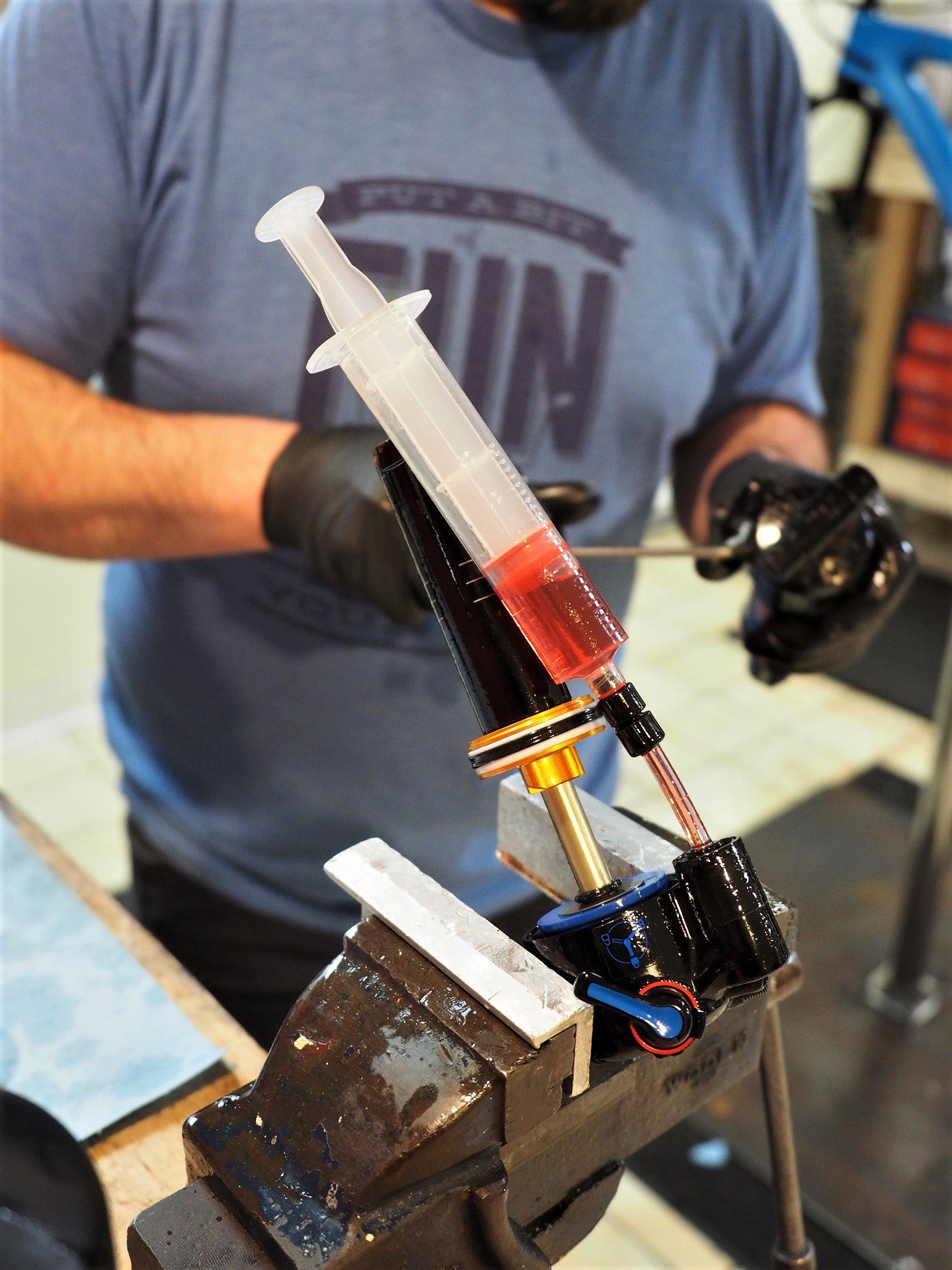
The only tricky part of rebuilding the RE:Aktiv Thru Shaft RockShox Deluxe shock is making sure the bleed is perfect. There needs to be a solid column of oil in the damper.
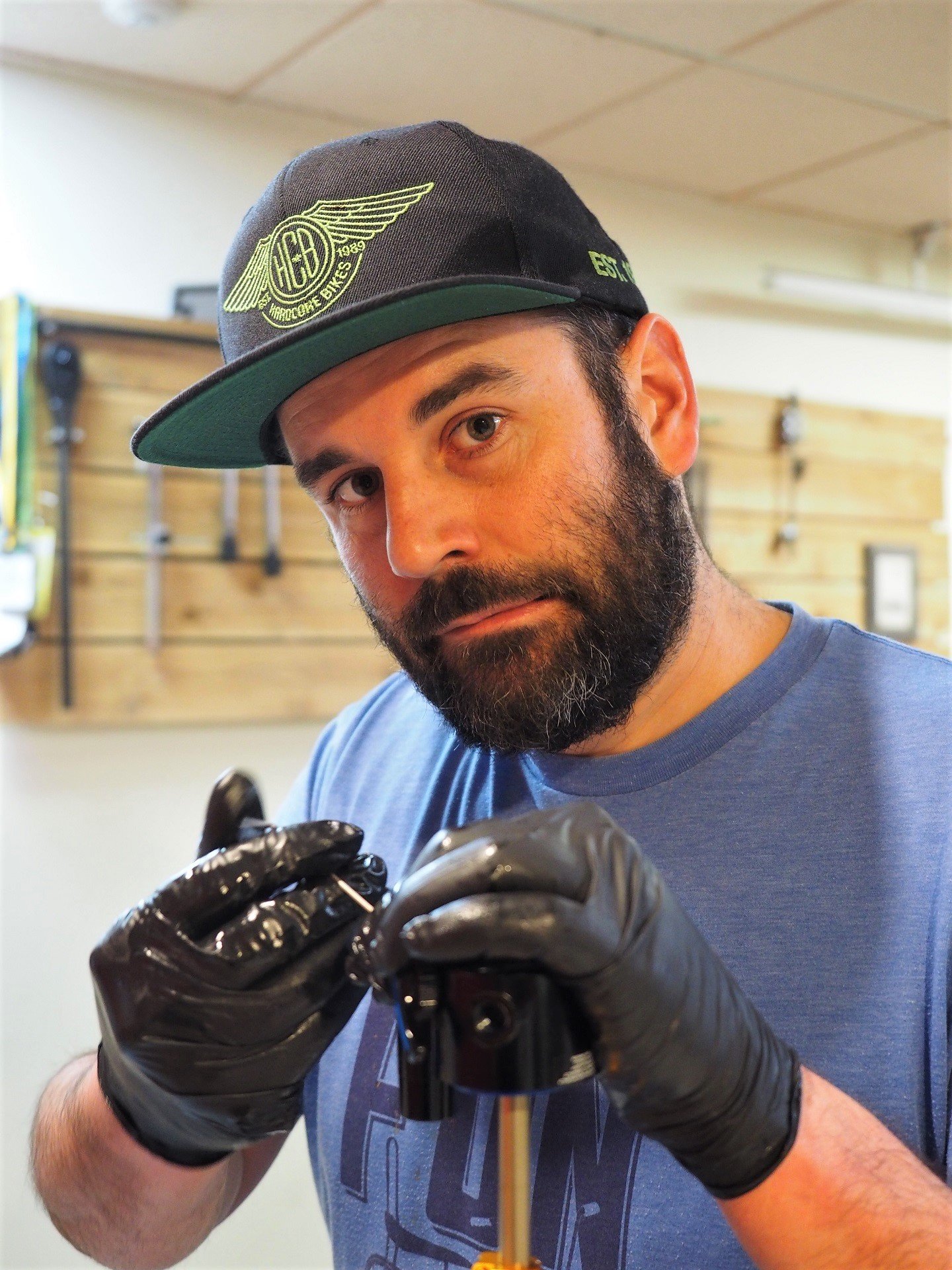
Jeff hamming it up for the camera. We tackled the shock rebuild blind but you don't have to. RockShox publishes awesome service manuals.
It's still highly recommended that the air can be cleaned and serviced every 50 hours. That's an easy job involving a strap wrench and some Slickoleum and possibly fresh seals. But the big news is the average rider is on this shock for a couple years between damper services and when the time comes it's a teardown that can happen locally from Whitehorse to Warsaw.
My question for Jose was what the shock feels like at 200hrs. Ridden hard, most dampers aren't performing properly when they hit their service interval but Trek is seeing no degradation of oil at the 200hr mark from any of their testers. I can't think of an air shock that comes close.
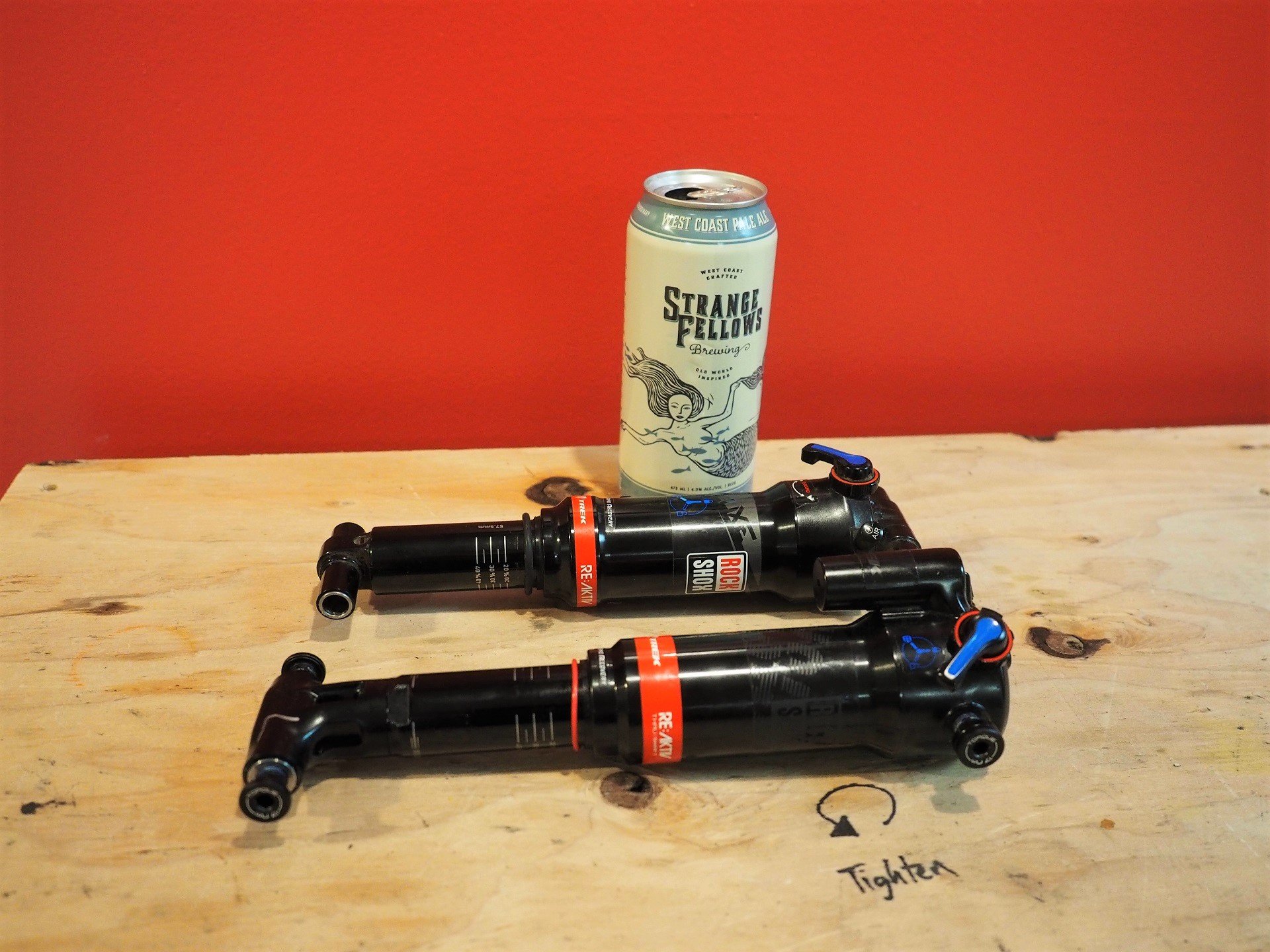
Last year's Remedy came with a RockShox Deluxe RTS with Trek's RE:aktiv regressive damping technology and a tune developed by Trek Suspension Lab.
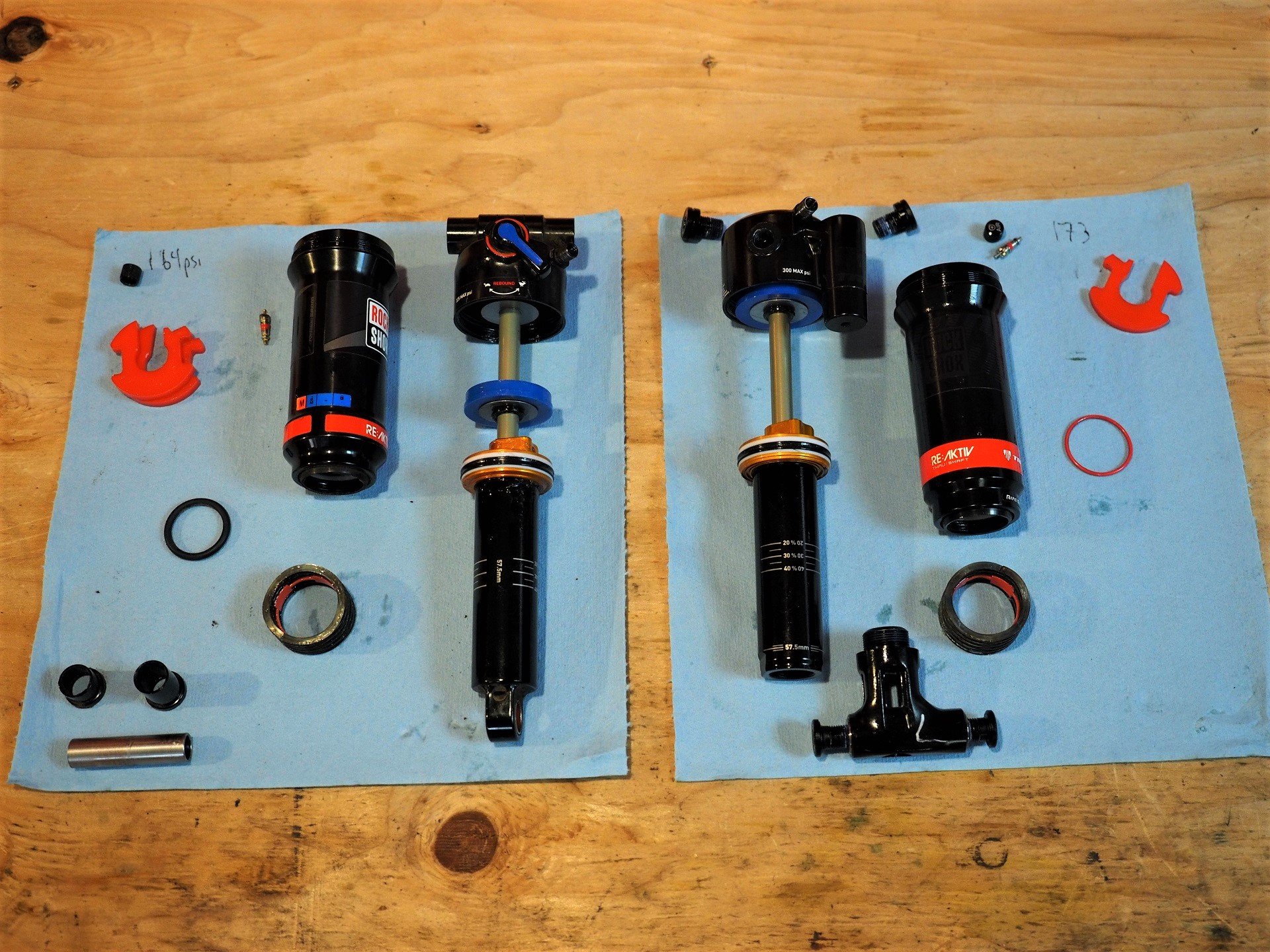
This year's bike has all that and Thru Shaft. In addition to the obvious improvements in serviceability and longevity I rode both shocks to try and compare performance.
Thru Shaft Issues
I have little doubt about Trek's performance claims. The shock's directional transitions are going to be faster and smoother with reduced friction and the low charge. The ease of service and longevity impress me enough that even if there was no performance gain I'd say this is a welcome innovation for riders. Or at least riders of Trek bikes.
The challenge with talking about Thru Shaft performance is related to the Remedy itself and specifically Trek's Full Floater suspension design. The fact is Full Floater Remedy bikes perform pretty damn well with every shock I've ridden in them from pre-Boost Valve Fox Floats, through the Trek-Fox DRCV shocks and including last years Deluxe RT3.
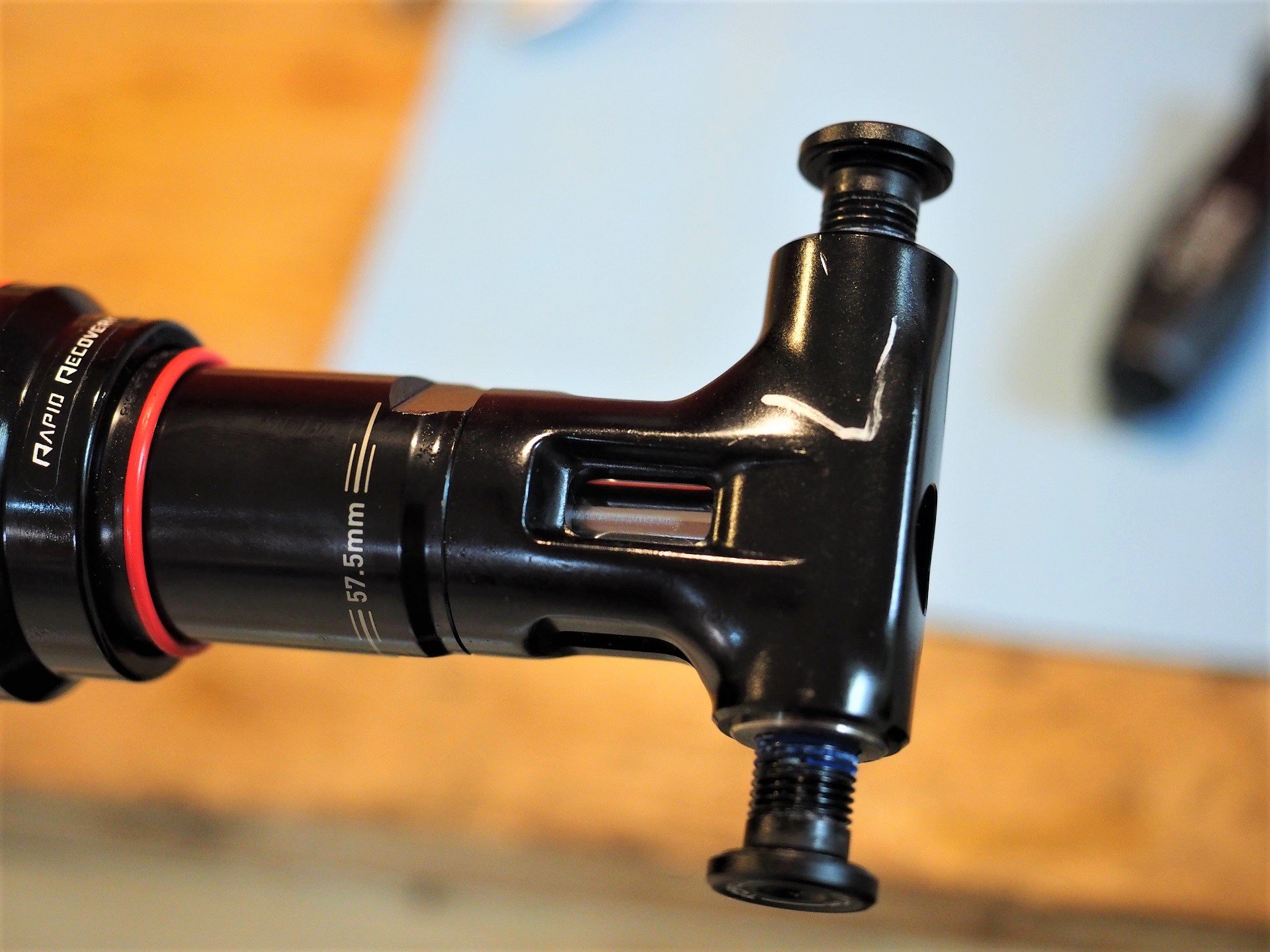
The threaded end eye allows the shaft to exit the shock. In addition to allowing the shock to function as designed this dissapates heat.
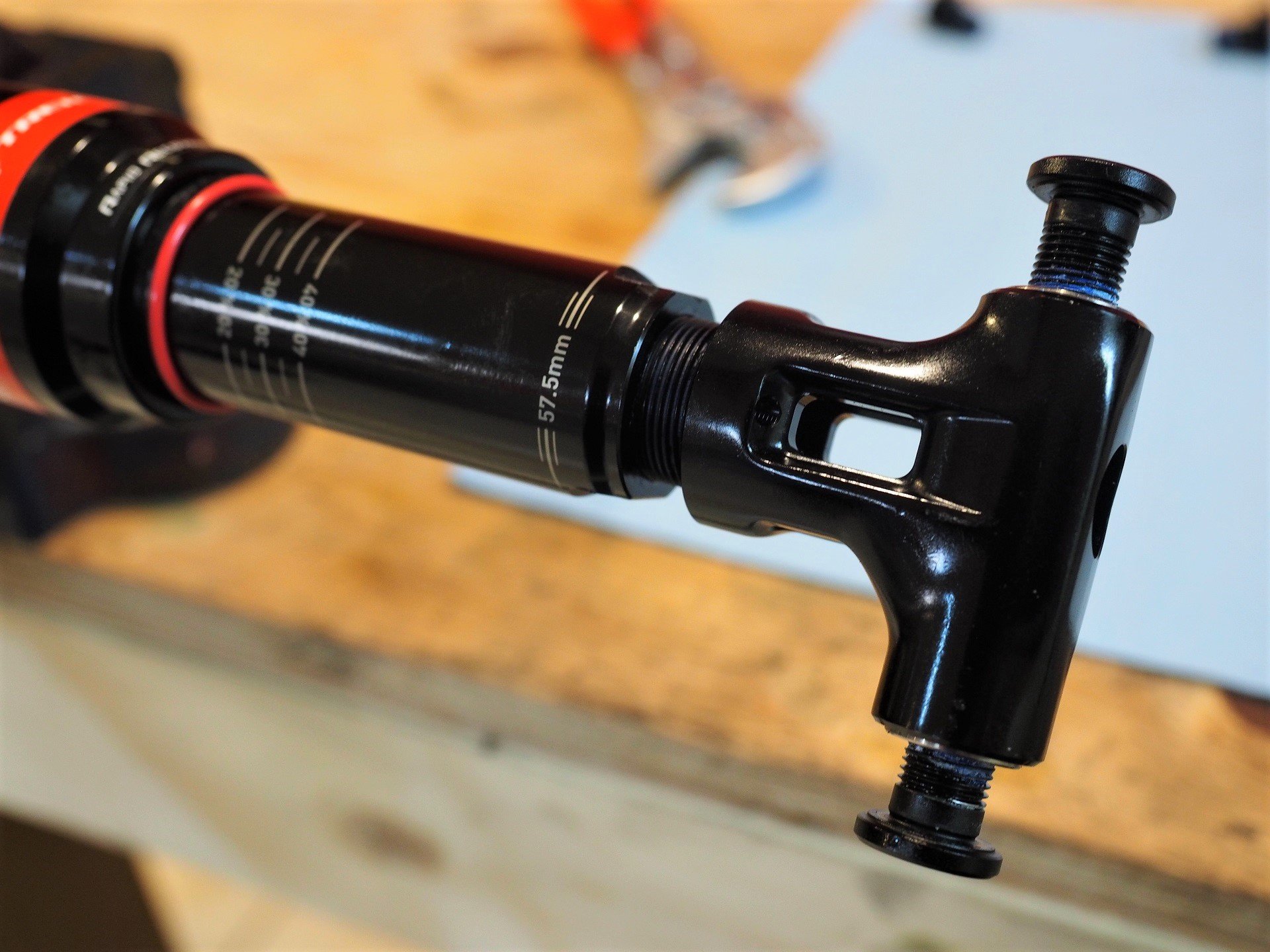
There's some internet chatter about durability but it's better protected than the shaft on a coil shock. In other words: no worries.
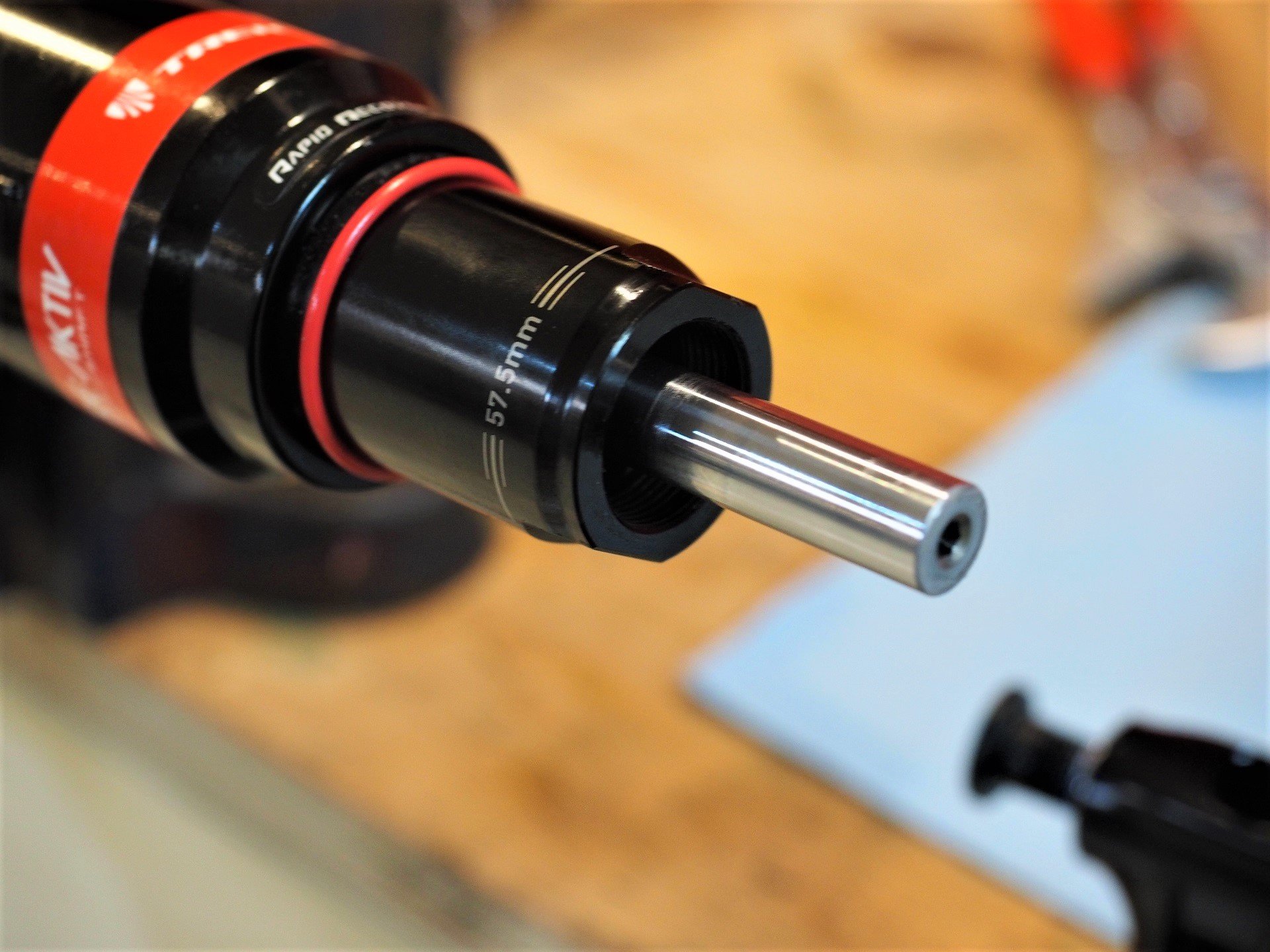
Likewise, there are no reliability issues with the seals which are also better protected than those on a coil shock.
Jose points out that Full Floater was developed specifically to address the shortcomings of the air shocks available when the first Remedy arrived and air sprung longer travel bikes were still a relatively new concept. It's a very easy suspension design to tune around between valving and air volume.
I can think of a handful of bikes that would be excellent candidates for testing the performance advantages of either the Fox or RockShox version of the Thru Shaft shock. Given the mounting system relies on bearings in the linkages, instead of the more common DU bushings, the best candidate would have been a Trek Slash like the one Perry tested last year.
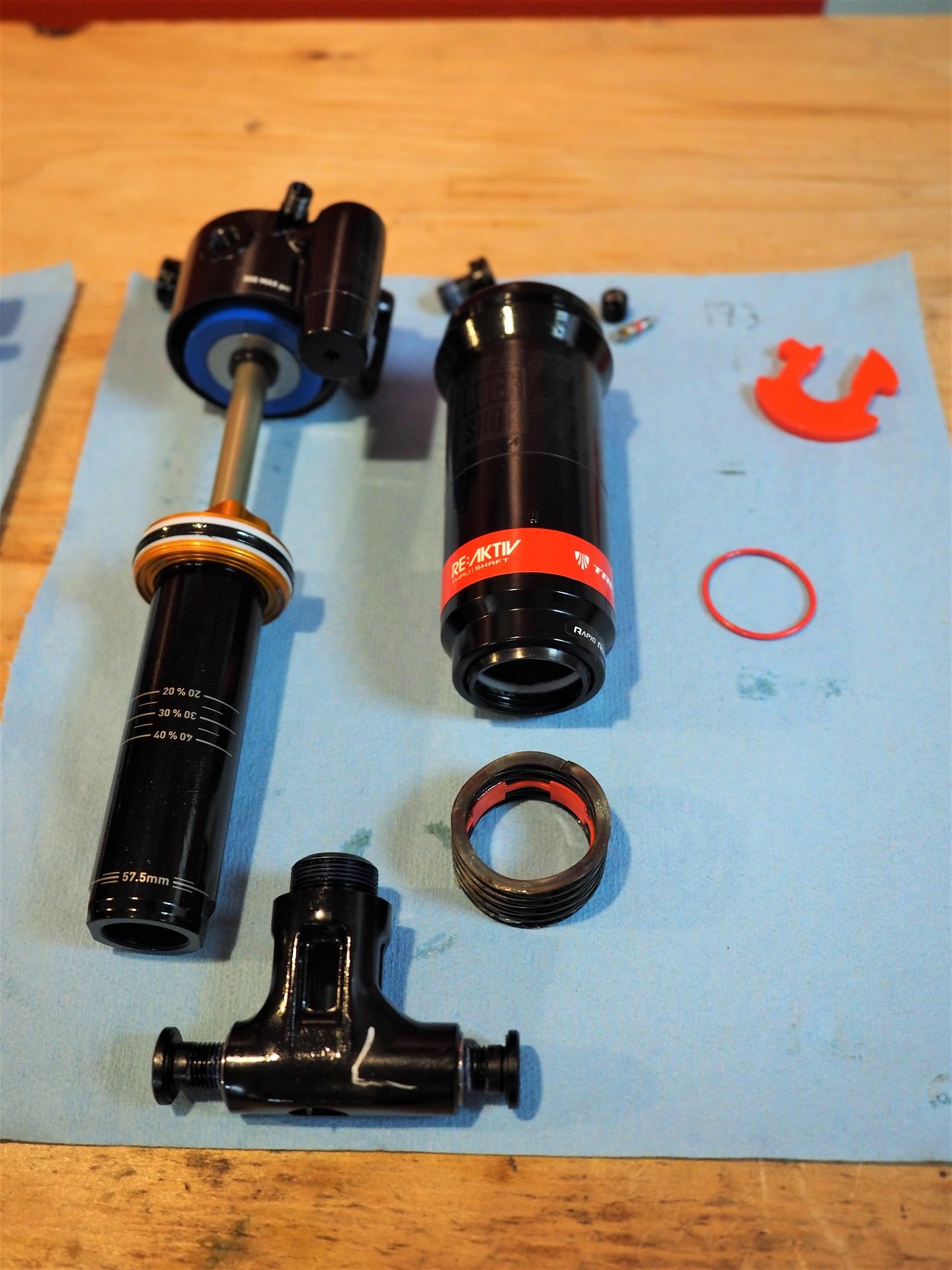
Standard RockShox volume spacers.
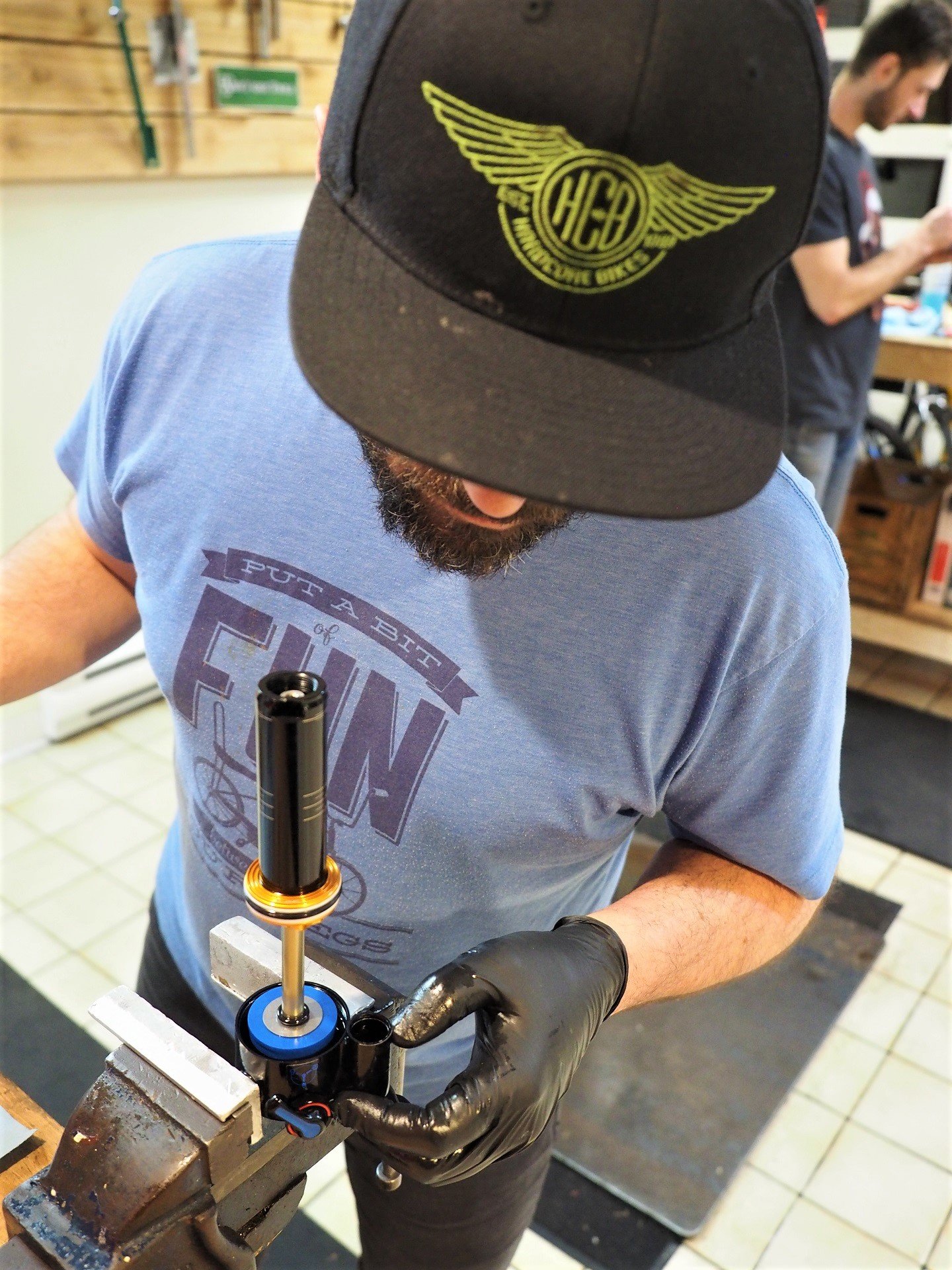
More on the reservoir in a minute.
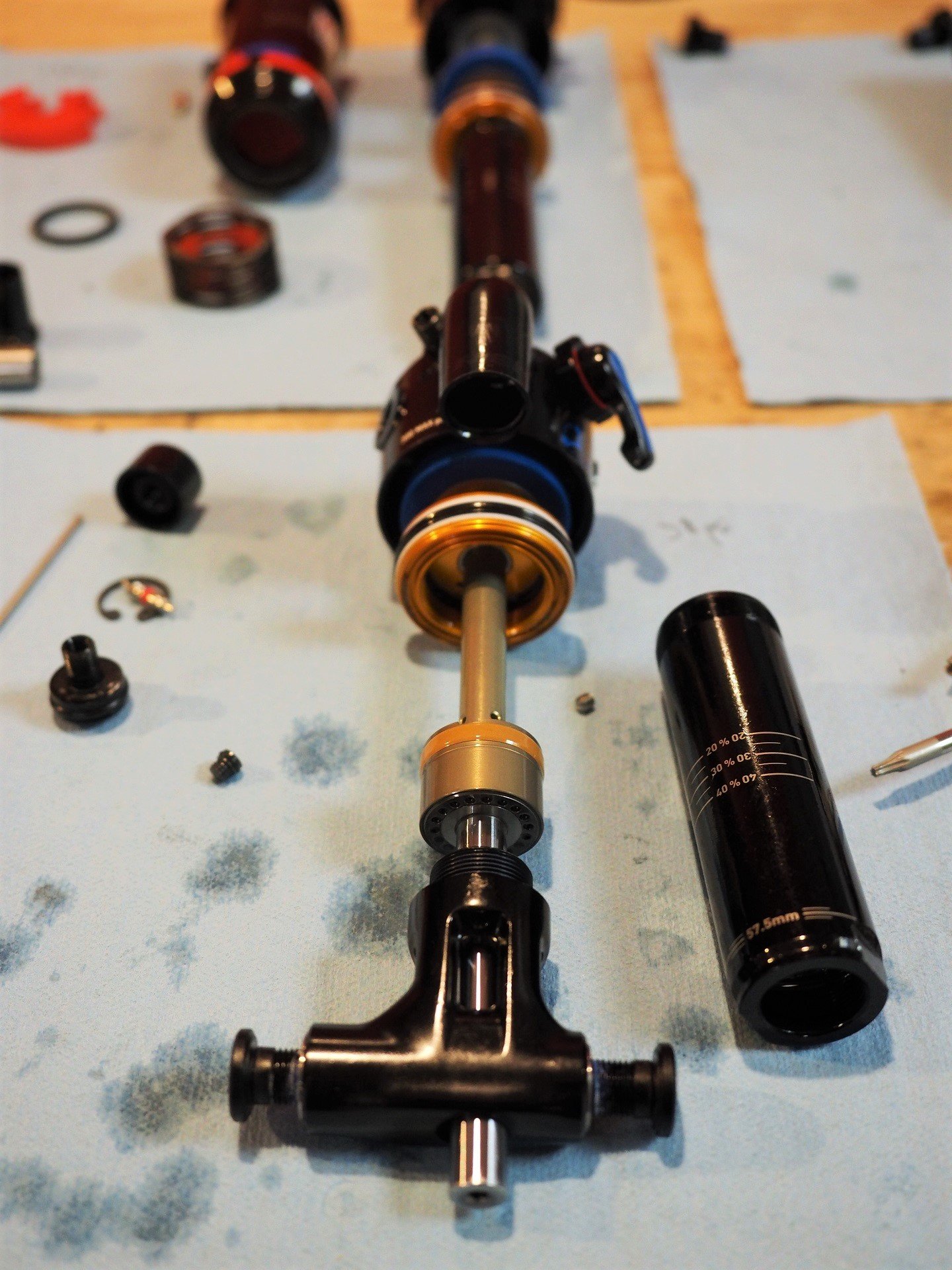
Thru Shaft and RE:aktiv guts.
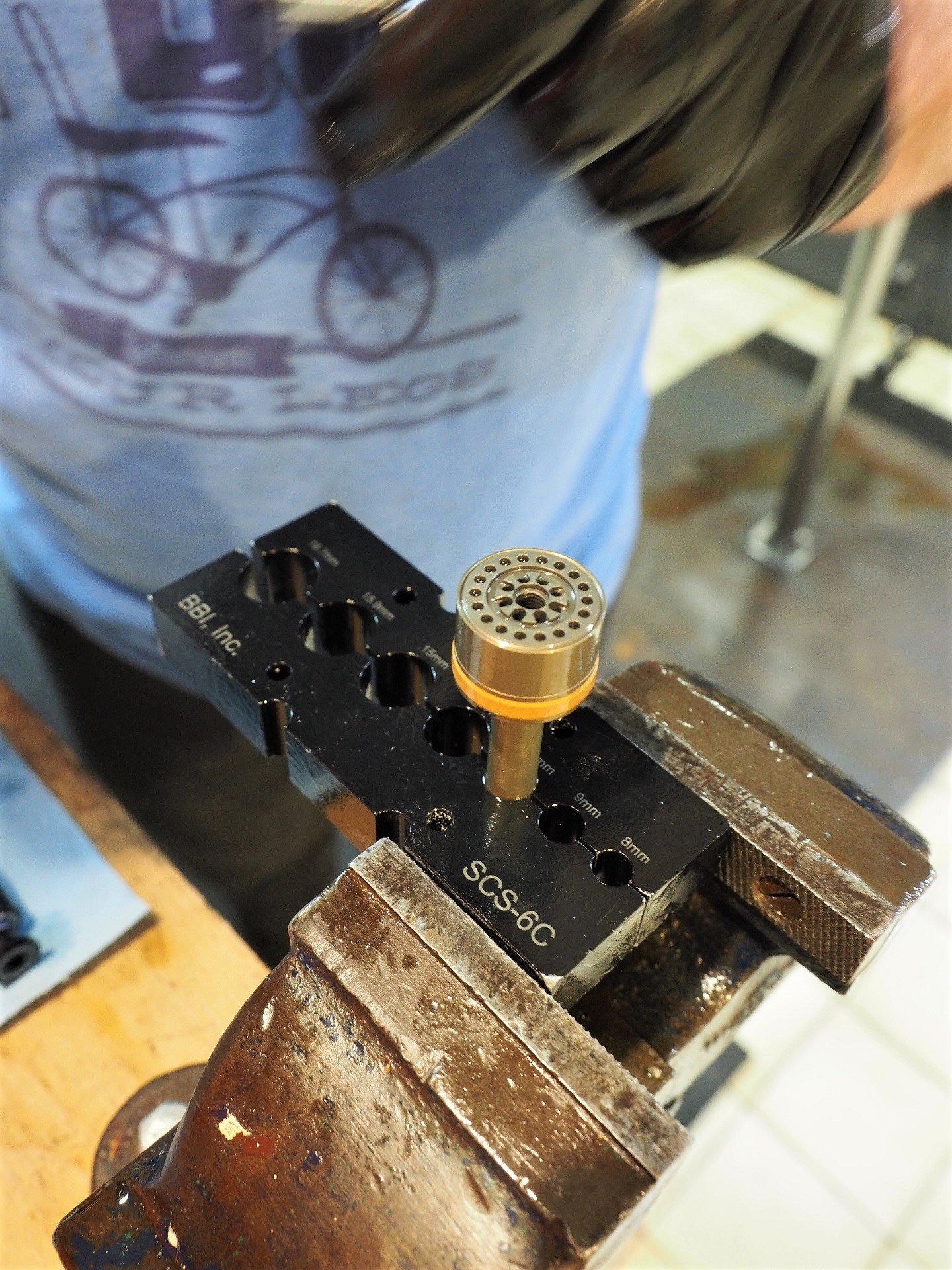
The Regressive piston assembly.
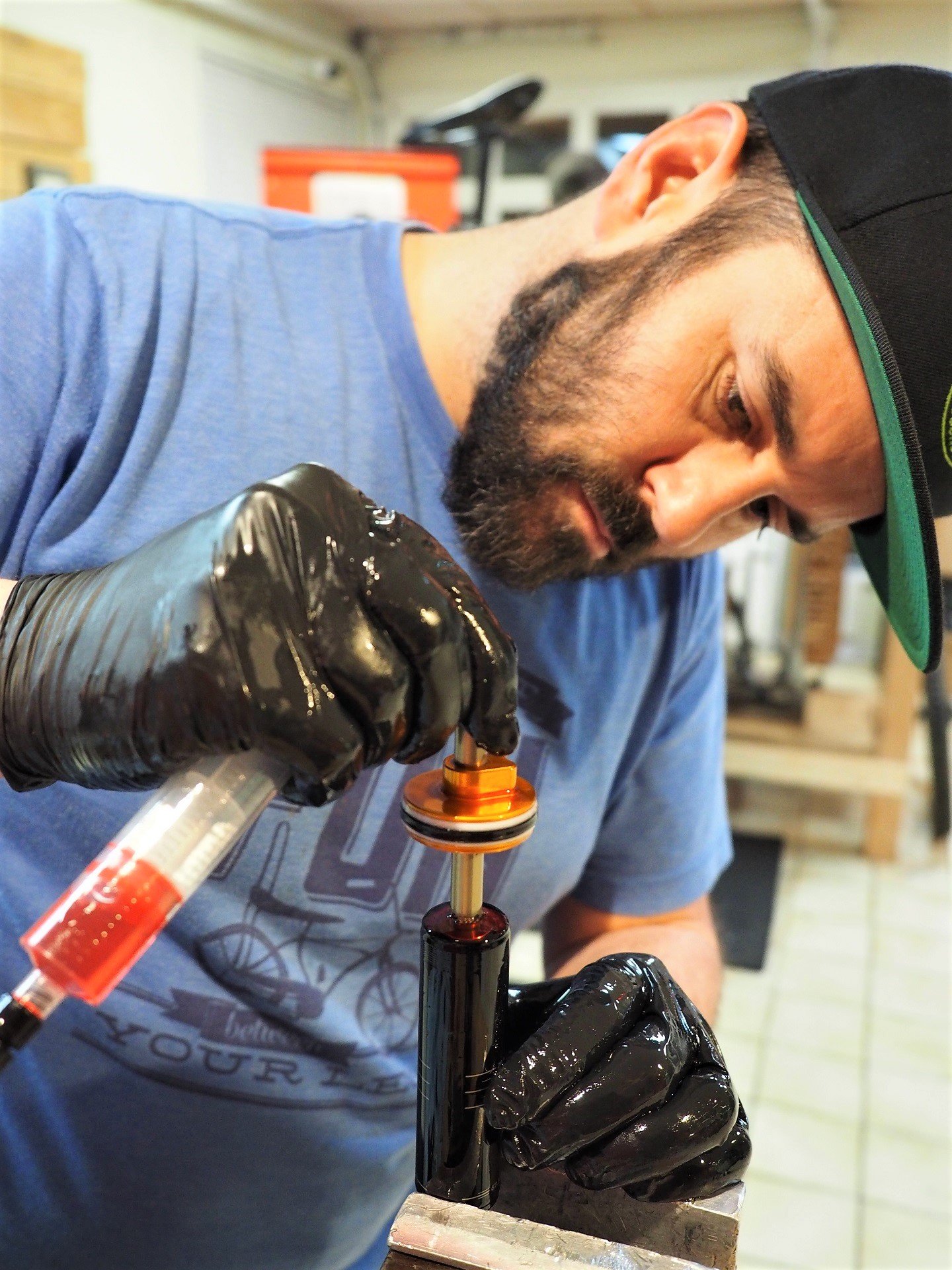
Jeff bleeds the shock.
It also took some reflection to get over the fact that technically the Thru Shaft shock does have an IFP. It's housed in the tiny reservoir and is backed by a 250psi charge via a discrete Schrader valve. Jose explained that the reservoir has no influence on dynamic shock performance.
When the Remedy is sitting static in my shop, the air pressure acts on the IFP in the reservoir to keep the system pressurized maintaining the solid column of oil in the damper. When the system is dynamic this reservoir is closed off from the shock and oil is pushed against the seal heads.
Remedy Ruminations
This isn't a bike review but I can't write about riding the Remedy without briefly discussing the Knock Block frame defence system. Boost fork crowns come with an increased stance. The greater width between stanchions means the crowns and adjusters are passing under frames much further along the down tube. Designing frames in every size to clear every fork on the market currently has resulted in some interesting looking bikes.
With the disclosure that I've never done an X-Up on purpose, I like the idea of restricting turning radius to keep the crowns, and my brake levers, from smoking my frame in a crash. I find that Knock Block delivers ample turning radius and reminds me a lot of my last Freeride bike with a Fox 40 up front where I could find the limit of turning radius and lean into it in steep and tight corners.
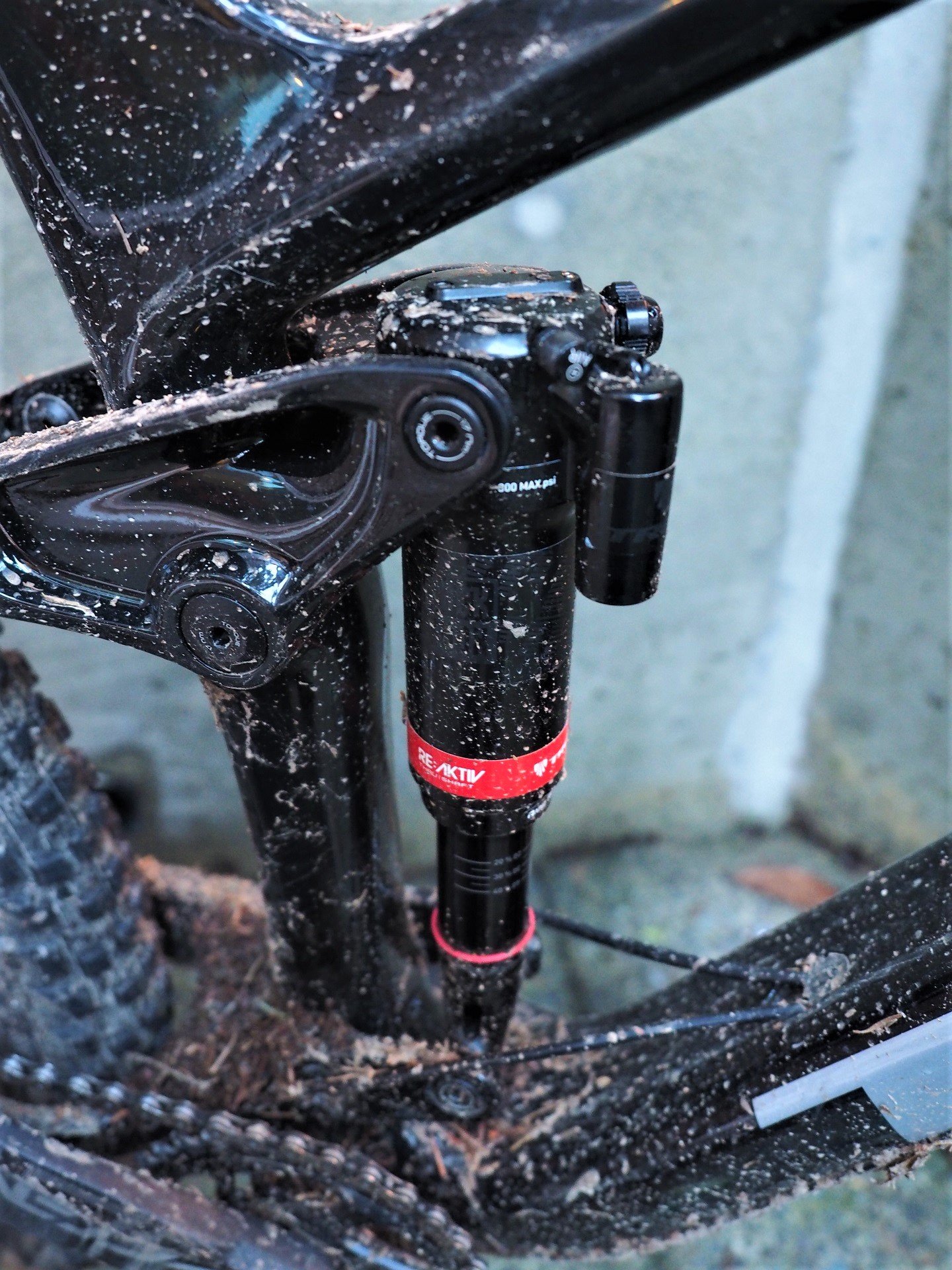
Trek provides base tunes for the air pressure on the Remedy. The shock reservoir is only in place to maintain oil pressure when the shock is static.
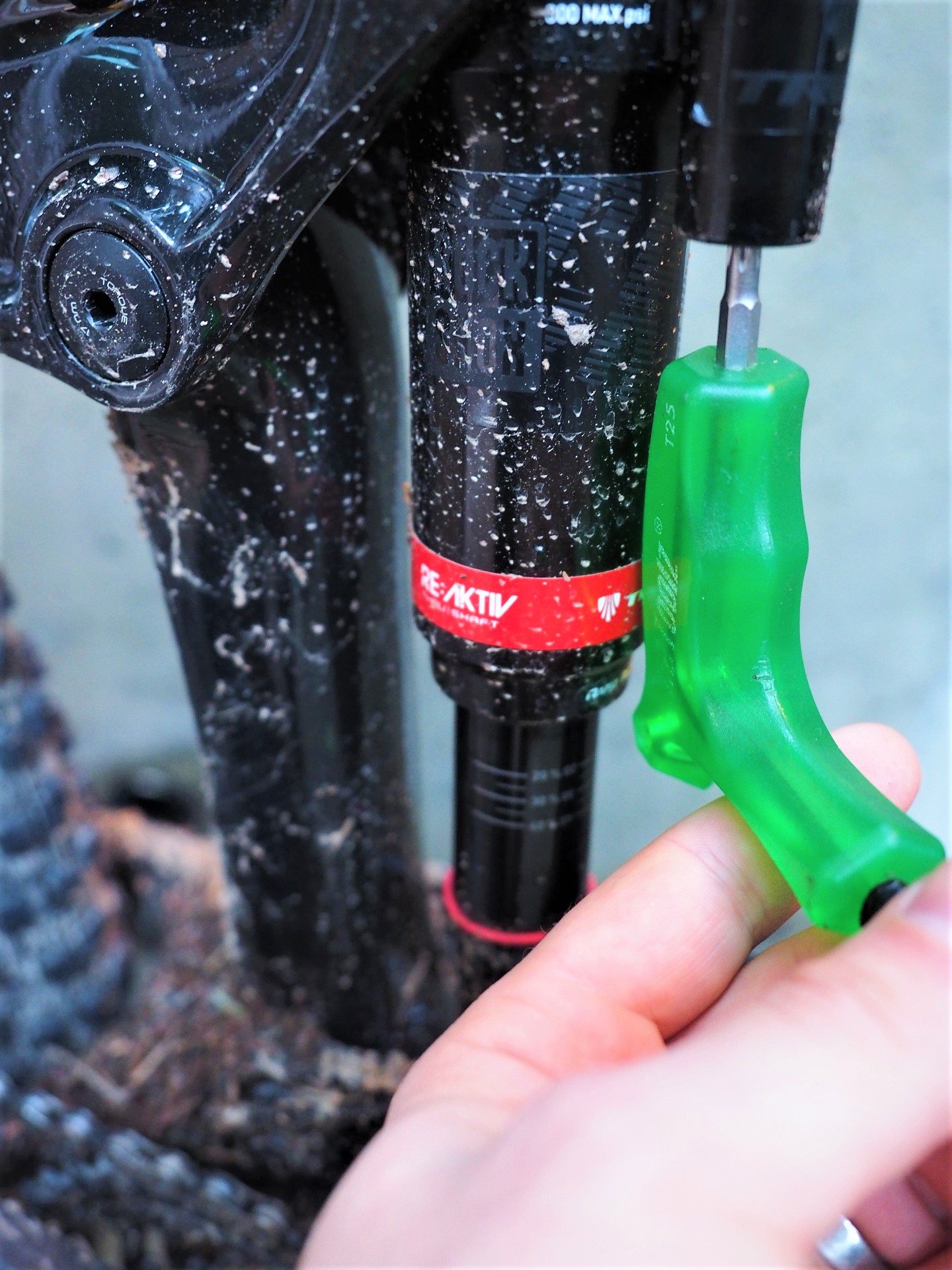
The reservoir Schraeder valve is hidden under a cap. It's accessed by a T-25 tool. Mine came with a low charge so I recommend checking it occasionally.
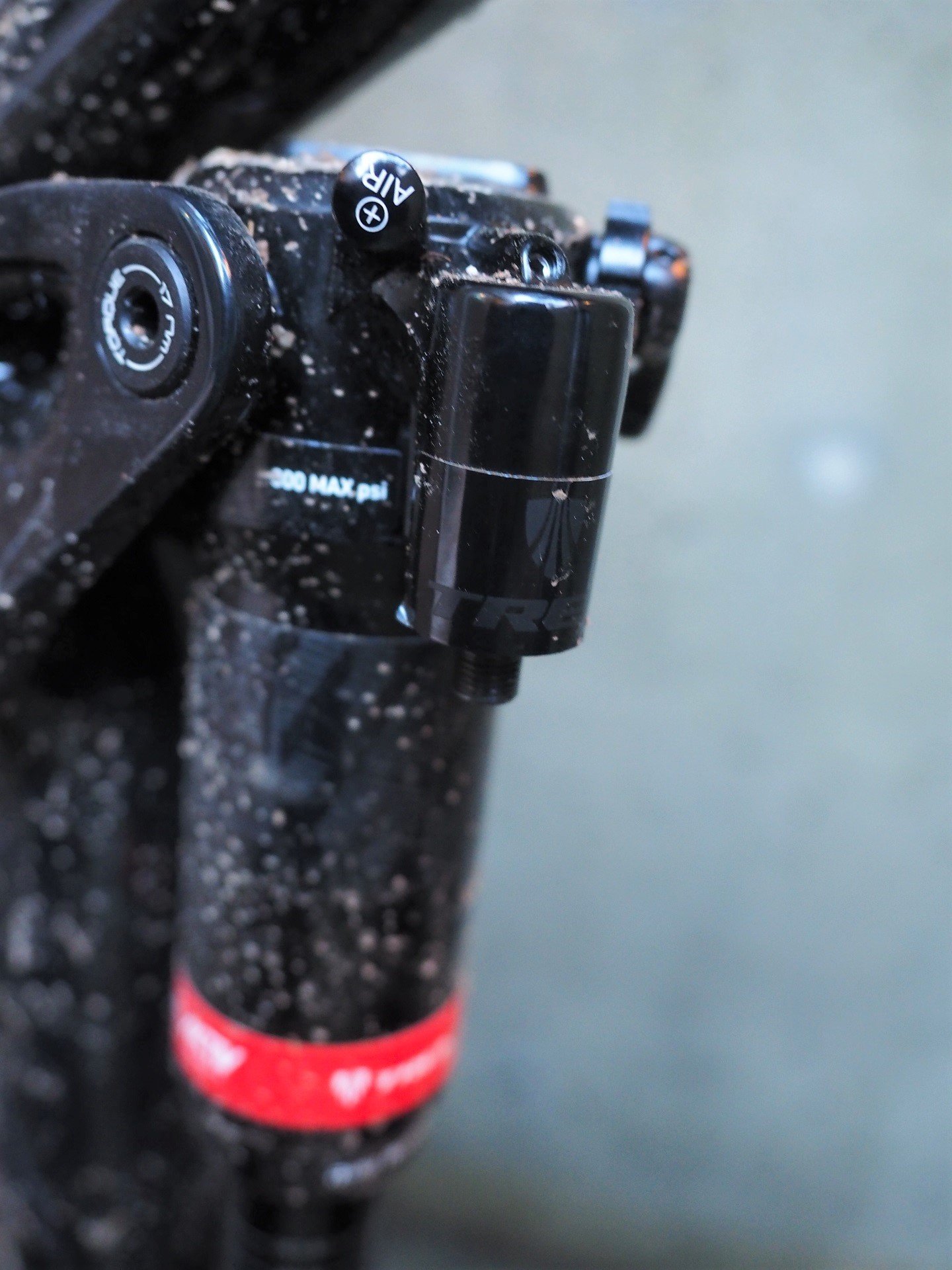
This reservoir gets pumped up to 250psi. Pressure doesn’t have to be exact as this has no effect on the shock when it’s dynamic.
I prefer the idea of a simple bolt-on rubber bump stop under the downtube, providing the same benefit without a special headset and interlocking stem. I know of a couple of cases of riders putting Boost forks on older frames only to find the fork controls contact their downtubes. Future proofing is good.
Riding Thru-Shaft
When Trek released the first RE:activ shocks, issues with noise in the first generation Fox DRCV models aside, the improvement was immediately noticeable in how much faster the Remedy moved across rough terrain. Climbing and descending performance were also improved. Then, factory air systems evolved and new air cans like EVOL and DebonAir replaced the complex DRCV system in delivering the performance Trek desired.
Last year RockShox replaced the parka-esque DebonAir with a simple air can they combined with their Countermeasure lattice spring. Combined with RE:activ and Trek's tune the shock delivered better small bump performance and better mid-stroke support. That action carries across to the new Thru Shaft shock but the question, given how well the 2017 Remedy suspension performed, is where I would hope to notice the difference in performance on the trail. Jose's answer was two-fold: repetitive hits and improved traction. Off to the jankiest sh*t trails I can find.
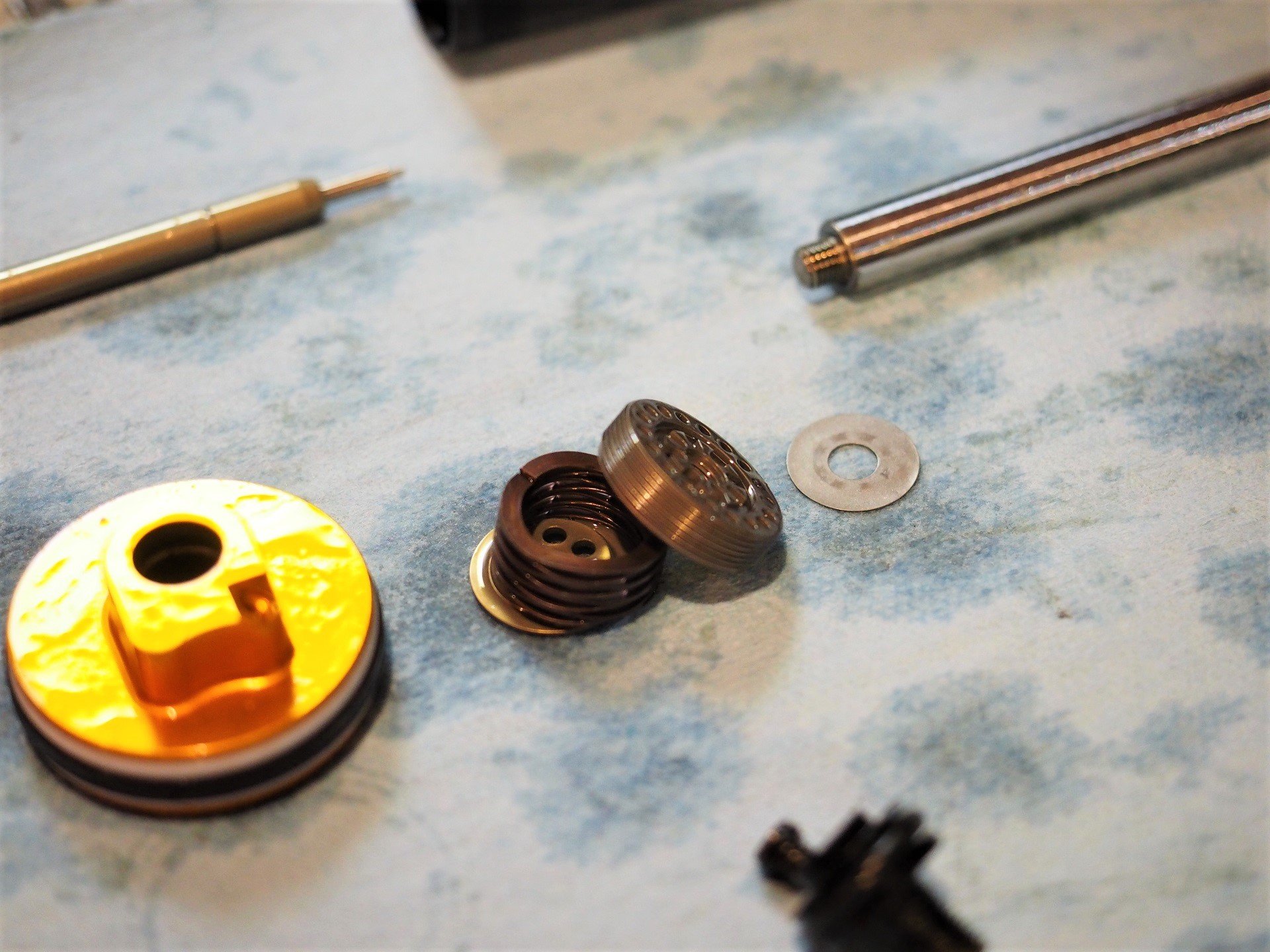
RE:activ: spring hat, valve spring, spring base, Regressive piston.
Performance over repetitive hits is subtly improved running a similar setup between the shocks. Pounding through rock gardens or down eroded chunder chutes the Thru Shaft shock recovers better after multiple hits. I noticed it especially on trails with wheel-eating roots and rocks where I would always choose to ride a 29'er but wasn't grumpy on the 27" Remedy.
I'm a big fan of Bontrager's SE4, and lighter XR4, tires for all around Shore riding and it's rubber I'm well acquainted with. Personally, the only situation I noticed a difference in traction riding the Thru Shaft shock or last year's RE:activ Deluxe was also on these mangled sections. Transitioning the Remedy down through flat rocky corners the same SE4 tires bite harder.
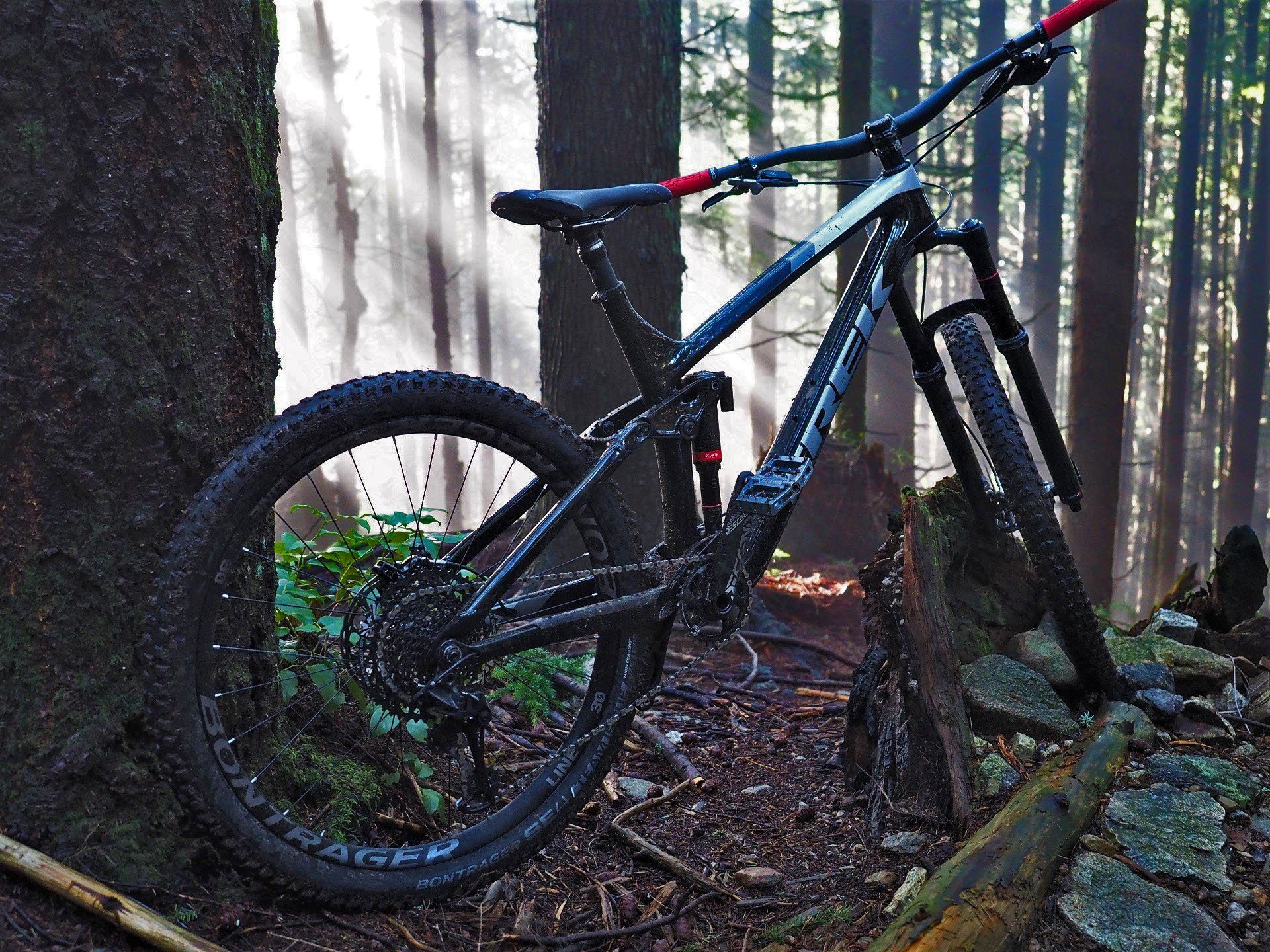
I rode the Remedy clipped in and with Flat pedals. Thru-Shaft improvements were more notable through the rough when my feet weren't locked in.
There is one mammoth performance improvement from Thru Shaft and I equate it to my recent experience running a coil shock on my own bike. Because Thru Shaft is so smooth off the top and in changing directions the shock can be run with reduced sag compared to any past Remedy setup. That means more support in the rough, fewer pedal strikes, and more travel in reserve for unplanned compressions. As a result I started with the Trek base settings for my weight and then ended up running the air pressure settings of a rider over 30lbs heavier.
Thru Shaft For All
Based on personal preference the Remedy wouldn't be on my purchase list because of the 27" wheels but both the 29'er Slash and 29'er Fuel EX are available with Fox or RockShox Thru Shaft shocks. If I had a 2017 Trek I would surely be looking into replacing my stock shock with a Thru Shaft model.
I wish the Fox or RockShox Thru Shaft shock was available for other companies' suspension platforms. It's the one air system I would consider running over a coil on my personal bike. It would also be a winning option for more linear suspension designs where the air spring, and ability to tune with tokens, is a performance key but the silky breakaway means a more supple feeling off the top.
Performance aside, the longevity and serviceability of the product put most other options to shame for the DIY or remote rider without ready access to performance shock service.
For more information on the RockShox Thru Shaft shock please click here. For more information the 2018 Remedy lineup please click here.







Comments
[email protected]
6 years, 2 months ago
Hi Andrew-
I'd like to correct a few things in your article here. My name is Dave and I did the thru-shaft project on the rock shox side of things.
_No dynamic internal floating piston (IFP) means no nitrogen charge. No nitrogen charge means the new Thru Shaft shocks are fully serviceable at your preferred local mountain bike shop or by any rider with the time, confidence, and tools. _
Thru-shaft does have an IFP- which is always connected to the rebound side of things (through the upper damper shaft). True it doesn't move with each stroke, but to say it doesn't have an IFP is false.
Also all Deluxe and Super Deluxe shocks are user serviceable. They simply require a special fitting and a special pump for higher pressures- available through most distributors. Same place you would get the special bleed tools to work on this shock.
_This reservoir gets pumped up to 250psi. It's a good idea to pump it up when checking main pressure. _
Please don't check IFP pressure when checking air pressure- there is no need to do so. The volume is so tiny- gauge loss on a normal shock pump will be 100psi or more. Then you have people thinking their IFP is leaking or low when it is not.
Finally the leaking issue- some shocks (too many) had the lower shaft seal rolled or cut on the assembly line during the initial production run- this issue has been solved. The good news is that if you got a bad one- it leaked immediately on the first ride. If the seal is good- the shocks are pretty bombproof.
Lemme know if you have any other questions.
Reply
Andrew Major
6 years, 2 months ago
Thank you Dave,
I should have been clear re. damper serviceability of the Deluxe and Super Deluxe shocks not requiring nitrogen. Thanks for the heads up re. special pump.
I do mention that the shock does indeed have an IFP but that it doesn't affect dynamic performance:
"It also took some reflection to get over the fact that technically the Thru Shaft shock does have an IFP. It's housed in the tiny reservoir and is backed by a 250psi charge via a discrete Schrader valve. Jose explained that the reservoir has no influence on dynamic shock performance."
I like to think that most riders who care enough to read a piece like this know how to calibrate a shock pump for loss during backfill of the hose and gauge. My reservoir was underinflated when Jeff and I tore down the shock.
Take care,
Reply
Brumos73
6 years, 2 months ago
Hmmm... how do you calibrate a shock pump? Never heard of having to do it.
Reply
Andrew Major
6 years, 2 months ago
When you attach a pump to an air cylinder (tube, tubeless tire, fork, shock, or dropper post air spring, etc) a certain volume of air will escape into the hose and gauge of the pump to equalize the system.
This will be different for every air cylinder and pump combination. For example attaching a floor pump to a tubeless tire with 28psi it doesn’t take much air to equalize where attaching a high-pressure/low-volume shock pump to an air shock with 250psi will result in a drop in pressure to equalize the system. Like wise, all my shock pumps take different volumes to equalize.
One real life example: I have a old RP23 that gets pumped up to 165psi. When I remove my pump (zero loss head) there is 165psi in the shock. If I re-attach my pump the gauge shows 145psi so it takes 20psi to equalize the system. The same pump vs. the Float 32 fork on the bike run at 65psi takes a marginal amount of air to equalize because the positive spring on the fork is much larger.
It’s important to know ~ how much air from a given air spring it takes to fill a given pump if you are going to comment on the air pressure in something you didn’t fill (i.e. don’t have initial gauge measurement)or are trying to measure loss over time.
In my real life example if my pump shows 100psi in my fork when I attach it but I know it takes ~20psi for the RP23 to backfill my pump/gauge then I can say my shock has leaked.
In the case of the reservoir on this Thru Shaft shock I took the measurement on my pump gauge and then experimented with different air pressures to figure out what pressure would give me my initial reading on re-attaching my pump.
Reply
Brumos73
6 years, 2 months ago
So in essence, you're pressurizing the 'system'. I completely understand what your describing, But that's not the same as calibrating a shock pump because that would imply your pump is reporting inaccurate values every time.
Instrument calibration is the process used to maintain instrument accuracy. The calibration process generally involves using the instrument to test samples of one or more known values called “calibrators.”
I'm pretty confident mtb suspensions aren't classified as calibrators.
Just nitpicking. I think your use of, "...know how to calibrate a shock pump..." is misleading.
Reply
Andrew Major
6 years, 2 months ago
Hi Bruno,
I understand the point you’re making - I’ve had a torque wrench professionally calibrated before.
It was the word that came to mind in terms of riders being aware of air loss into their hose/gauge and figuring out how much is lost when Pump X is attached to Shock Y.
Apologies for the lack or clarity; I certainly wasn’t intending to confuse. I think I’m within the dictionary definition of calibrate but another word may have made the point clearer.
MaWa
6 years, 2 months ago
That sounds great. Really.
But I do know a bikeshop that had the first bikes with Thru Shaft Technology and all dampers were leaking out of the box. So not really a durability issue. But there seems to be a problem with that technology right now.
Reply
Andrew Major
6 years, 2 months ago
Sounds to me like Fox or RockShox (you don’t specify which Thru Shaft shocks) had a problem with bad seals.
The damper seal/shaft cycling doesn’t work any differently than a coil shock so there’s nothing inherent to the Thru Shaft technology that would cause the damper to leak.
Reply
Andrew Major
6 years, 2 months ago
Please see the comment by Dave@RockShox below re. seal/assembly issue. Leaking not related to Thru Shaft tech.
Reply
stinky_dan
6 years, 2 months ago
What coil and on what bike? I'd be very interested to hear your experiences with that.
I'm looking at shock upgrades and try to balance out the coil vs air argument in my head.
Reply
Andrew Major
6 years, 2 months ago
In my mind, the coil vs. air argument is a simple two-stage process.
1) Will my bike perform well with a coil shock?
A lot of bikes are designed to work best with the inherent progressiveness of an air spring and a lot of riders have really come to enjoy being able to easily tune how progressive their forks/shocks are using tokens.
If the answer is no, then stick with the air shock. Depending on what air shock you have there could be upgrades, valving options, or replacement models that will significantly increase performance on your bike.
2) If yes, do I care about weight?
Even with the new lighter springs from Fox, Cane Creek, PUSH, and etc a coil shock will add weight. How significant the penalty depends on what your bike weights now and usage. A 25lbs carbon trail bike super sled? It’s a big jump.
My personal rig is an aluminum Marin Rift Zone with alloy wheels, a GX drivetrain and smorgasbord of miss-matched parts and I ride a lot on my own so if a few pounds of bike add a few minutes to my climb up No Quarter I'm really not stressed about it.
I have a used Cane Creek CCDB CS coil that SuspensionWerx rebuilt as a metric (210x50) shock to fit my Marin. It's not particularly light as coil shocks go and I'm running their standard spring not the new lighter Vault spring so the weight increase was significant.
My bike has 120mm of travel so being able to get great traction while running my suspension a bit firmer (spring rate) keeps my bike riding high pedaling in and out of the saddle (I stand a lot) while the lack of stiction makes everything move directional changes seamless.
If you have a bike that will work well with a coil, are legitimately not concerned about the additional weight and have the budget to buy one then I can't think of any reason to run an air shock over a coil.
Reply
Martin
6 years, 2 months ago
Hi Andrew!
I am coming from a fully coiled freeride bike so I'm interested to see how a coil shock behaves on your Marin ; ) It's good to know that Suspension werx can resize a coil shock too, I'll contact them. Too bad that the thru-shaft technology isn't available for other frames as I most often choose suspension parts based on serviceability and long service intervals.
And as a side-question concerning the down tube stopper on the Trek, have you had any problem with boost-width-forks' downtube clearance on your Rift Zone?
Thanks!
Martin
Reply
Andrew Major
6 years, 2 months ago
Hi Martin, to date I’ve only had my non-Boost X-Fusion fork and the Boost Mattoc on the Rift Zone. No clearance issues with either but not much of a definitive list.
Reply
stinky_dan
6 years, 2 months ago
Was the addition of the Climb Switch a 'must have' for you in terms of pedalling stability? Had you tried other coil shocks without a climb switch?
Reply
Andrew Major
6 years, 2 months ago
Short answer: No. CS not a factor.
Long answer: I have yet to use the Climb Switch except on the road. Bike stands up well without it for both seated and standing climbing.
That said, the Marin is clearly designed around 1x drivetrains by people who are adherents to the church of anti-squat. There are plenty of coil friendly bikes that rely more on shock damping for pedaling support where I would be flipping the CS on any time the trail pointed uphill.
Reply
stinky_dan
6 years, 2 months ago
A great point about the Marin design. I'm in the 'ride up grudgingly' category anyways and usually in the dark.
Reply
PoCo_Rider
5 years, 11 months ago
Hey Andrew,
Were the limitations of the turning radius noticeable? If so, where or what situations did you notice it? I was curious about the double crown fork turning radius comment because I took a one day lesson at WBP riding a bike with single crown fork and when we through one of the tighter trails through the trees, I passed the rest of the class who were struggling to steer through the tight turns.
I rode a 9.8 in tight circles in parking lot and I didn't seem to have any issues. I plan to demo one in a couple weeks.
Reply
Andrew Major
5 years, 11 months ago
I never noticed it in a negative way climbing or descending.
On Griffin switchbacks, for example, I would just crank the fork against the steerer stop and lean the bike enough to cut the radius of my turns. Sure, it's a bit like riding a dual crown... but a really wide dual crown like a Fox 40.
It would have no bearing on my bicycle purchasing decision (take it or leave it).
On a positive note since your bars can't spin you can trim all your cables/housing so they're super clean looking without worrying about tearing out a brake line.
.
The only thing that really irks me is the proprietary stem. The workaround is Trek's locking Knock Block Spacer, which is a replacement for a 1cm spacer. I would prefer if the bikes included the spacer but then it's not possible for folks to slam their stem if they're trying to get their stack height down (not an issue for me).
The Bontrager stems are of course totally fine, but I'd prefer to combine the 1cm locking spacer with my choice of rudder.
If you do decide to go that route I'd highly recommend having some spare pants nearby by when you drop-in, call-up, or read the e-mail response inquiring about the price of said locking spacer.
Reply
PoCo_Rider
5 years, 11 months ago
Thanks Andrew,
Actually, the knock block is the only thing that is making hesitant to purchase the bike. The bottom line for me is if I am hitting the knock block limit in a situation where I would just steer through on another bike. I was going to try GSM.
Cheers,
Brian
Reply
Andrew Major
5 years, 11 months ago
Definitely wasn’t an issue for me on the Remedy on GSM. No problem riding through #3 and XMas corners.
On R&R I definitely hit the hard stop in the tight left to start the switchbacks before the uphill log ride. Still pedaled through no problem and I think that’s a situation where the Knock Block can help as I’m not fighting the tire’s tendency to flop over when steered past a certain point on a bike with a slackish-to-slacker HTA. This tendency is greater with a 29” wheel so if anything I think I’d appreciate the KB more in this specific situation on a Fuel.
Downhill there’s a few cornering situations on Pipeline where I hit the hard stop in steeper sections with tight turns at the bottom. A bit disconcerting the first couple of times but not a problem when expecting it.
Reply
Memo Meray
5 years, 11 months ago
Hi Andrew,
I don't know if you had any chance to compare them, but if you had, is there a big difference between the RE:aktiv and Thru Shaft RE:aktiv shock? I would like to buy a bike with RE:aktiv shock, but the Thru Shaft ones are on built in expensive models. Does it worth the price difference?
Cheers,
Memo
Reply
Andrew Major
5 years, 11 months ago
Hi Memo,
All other things being equal, I think the Thru-Shaft shock is worth the extra money. As I said, I wish it were available for other bikes.
Rude quality is great and (Fox or RockShox) they should prove to be much more resilient than other air shocks (both seals and damper fluid).
I hope that helps!
Check out my review on the Line Comp wheels (+ upgrade as well). A Fuel EX with Line Comps, Thru Shaft shock and an XT/SLX or XT drivetrain would certainly be on my shortlist for a new bike in terms of value:
Max performance for minimum maintenance, upgrades, and cost.
Reply
Memo Meray
5 years, 11 months ago
Hi there again Andrew,
Thanks for the info. I'm looking for a full suspension with shock control. I have tested Specialized Brain, but I was not that much happy with it. I find Scott Spark interesting, because it has more control on the shock. Unfortunately I was not aware that Trek RE:aktiv is a shock which functions automatically like Specialized Brain, but with another system. Do you have any idea or comparison between Trek and Scott full suspension bikes?
Kind regards,
Mehmet Meray
Reply
Andrew Major
5 years, 11 months ago
Hi Mehmet,
That's a lot of very different animals.
The BRAIN Shocks have been getting progressively better at being sensitive to terrain while making their bikes efficient. I'd love to try the newest version of the Specialized Epic just to see what it's like - especially with updated geo.
I would not compare the RE:Aktiv system to the BRAIN.
I'm not a fan of bar clutter but I will say that the latest Scott Twinlock remote is very clean. I haven't ridden one of these bikes recently enough to say how the performance is in open. I've ridden past Scott bikes with Twinlock and I used the remote a surprising amount.
Keep in mind that when it comes to remote lockouts for Fox and RockShox shocks the answer is always "it's possible" and the follow-up question is "how much?". For example, if you wanted to ride an already efficient bike like a Kona Hei Hei 29'er but wanted to also have a remote lock-out this is an add-on option that your local shop can arrange for you.
I don't personally like having my suspension locked out (I love hardtails but when I ride a dual-FS bike I want the traction I'm pedaling around and paying for). I do love the Climb Switch of Cane Creek shocks and Cane Creek makes a great remote that cleans up the interface of their climb switch and a dropper remote (just like the Scott). The big difference is Climb Switch retards the compression and rebound circuits of the shock so the rear end of the bike stands higher but still provides tons of climbing traction and even some small bump compliance. There's also no harm in running these shocks with the CS engaged where some lock-out system really don't like it.
Hope that helps,
Andrew
Reply
tonik
4 years, 11 months ago
Hi is there possible the change all damper oil from ifp bleed screw and bleed damper from that point?
Reply
Please log in to leave a comment.